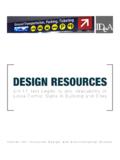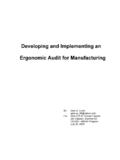Transcription of typography for visually impaired people - Text Matters
1 TypefaceThe choice of typeface is less important than contrast, type size, weight and the spacing of , unusual, script and titling faces are obviously highly inappropriate for legible continuous is no valid research to support the preference for a sans serif typeface (such as Arial or Helvetica) over a seriffed one (such as Times or Century). Seriffed faces are regarded as more readable in continuous text for regular reading. This may equally apply to large print sizeFor the partially sighted 9 12 pt type (or an average x-height of ) is suggested as a minimum by RNIB. Sometimes 16pt may be needed by some visually impaired recommendations obviously depend upon the typeface and weight used.
2 For the general reader type sizes between 8 and 10pt are frequently used. The RNIB aims to set all its texts for usual readers in that different types with the same point size have different appearing sizes. The effective size of a typeface is actually related to the height of the lowercase weightThe tendency has been for setting text in bold because of its contrast on a white page. However, more recent findings suggest that a medium weight or semi-bold may be more legible. The RNIB s See it right was set in New Baskerville semi-bold. We suggest avoiding weights of fonts that appear very light. Aside from the weight of the stroke, the counters of letters are important they should be open to help italic type should clearly not be used for continuous text for any group of readers.
3 As a means of emphasising important words or phrases it may be appropriate. This is particularly important if body text is in a semi-bold; the use of bold for emphasis will not be enough. Titles of books etc. should be italicised as in text for general notes sum up research and experience in designing paper documents for visually impaired people . Written in September 2001, they are based on recommendations from the Royal National Institute for the Blind, The Lighthouse Inc, other research and, where there is no better guide, our own taste and Matters 37 Upper Redlands Road Reading RG1 5JE United Kingdomt: (+44) 0118 986 8313 f: (+44) 0118 908 0732e: w: Arial 16pt PerpetuaThe point size of a typeface is not the same as its apparent sizetypography for visually impaired peopletypography for visually impaired people page 2 of 3 Text Matters , 37 Upper Redlands Road, Reading RG1 5JE, United Kingdom t: (+44) 0118 986 8313 f: (+44) 0118 908 0732 w.
4 That the italic versions of most seriffed fonts are very different from their roman equivalents; some would be tough going for visually impaired readers. Italic versions of sans-serif fonts are normally just sloped versions of the roman and should not have the same potential lettersText in capitals is much harder to read than normal-case continuous text. However, one or two words set in capitals do not create reading problems. Because they are bigger, capital letters are easier to see than lower-case letters, so may be suitable for is important that numbers are as distinct as possible. This is particularly vital for documents such as bills, bank statements, and accounts.
5 Some typefaces have figures that are easily misread: 3, 5 and 8, as well as 0 and 6 can be easily the figure one 1 can be confused with I, and l and even ! A hooked number one is much more distinctive than a straight vertical stroke 1 . Choose a typeface with distinctive numbers. The RNIB publication See it right had its New Baskerville figures redrawn to improve readability and help increase the distinction between different spaceLeave reasonable space between lines of type. RNIB suggests interlinear space should be at least +2pt for type sizes between 14pt and 20pt (eg. 14pt type with 16pt leading). This of course depends on line length and on the x-height of the type you are using.
6 Lighthouse recommends adding 25 to 30 per cent of the text point size between lines. We re with Lighthouse on this one. Text set in longer lines needs more interlinear space than text set with a narrow measure (see Line length and line endings ).line length and line endingsThis should ideally be in the range of 50 65 characters. Some visually impaired people may prefer even shorter lines than splitting words at the ends of lines. Switch hyphenation modeUse unjustified, ragged right, text setting with even word spacing. Do not justify text: this creates uneven word spaces and makes the text harder to read. This appears to reflect research among regular readers which suggests that unjustified text is easier to read at the margins of reading ability: with beginning readers and those reading in poor spacingAlways use even word spacing.
7 In some documents for the visually impaired there has been a tradition to use double word spacing. This has not been fully researched. While it may help some readers, others may find double word spacing actually hinders italicArial italicItalic of a seriffed typeface versus a sans serif italic1 l ! I1 l ! I1 l ! I1 l ! I1 l ! IGill Sans regularBaskervi lle regularJo anna MT regularMeta-Normal regularCharacters that are not always easily distinguished in a font: the numeral 1 , letters l and I , and the symbol ! typography for visually impaired people page 3 of 3 Text Matters , 37 Upper Redlands Road, Reading RG1 5JE, United Kingdom t: (+44) 0118 986 8313 f: (+44) 0118 908 0732 w: space between paragraphs.
8 There should be more space between paragraphs than between lines. Other ways of setting paragraphs such as only indenting the first line or out-denting the first line may make text less easy to read for visually - impaired should be clearly differentiated from the main text using some combination of size, weight and space. Capitals should not be used for headings, nor should out-denting. A second typeface such as a sans serif in contrast to a serif body text could be used, but no research has been carried out to prove its effectiveness. Headings in bold are clear as long as there is plenty of contrast between the weight of the heading and that of the seem easiest to read when ranged left with the text.
9 It has not been established whether centred headings are harder to read than ranged left ones, though common sense suggests that they space around headings helps to differentiate them from main the past, documents for visually impaired readers often used underlined headings. There is no conclusive evidence that this assists and layout Layouts should be simple and clear with recognisable patterns for levels of heading, numbering systems, and treatment of specific information. Generous margins for pages of text help reading as they don t lead the eye off the text is set in columns make sure the space between columns is generous. If space is limited, use a vertical rule.
10 It is helpful to provide navigational aids for the reader such as a contents list for multi-page documents, and rules to separate unrelated sections. formsOn forms, visually impaired people often need generous space to fill in hand-written details. Their handwriting tends to be larger than average, and visual impairment, particularly in older people , is often accompanied by other physical problems which make it hard to write neatly. This means they need more widely spaced lines or larger boxes to fill in than those on conventional forms. This also applies to tick issuesThis brief overview is by no means comprehensive. There is now a wealth of information about designing for visually impaired users.




